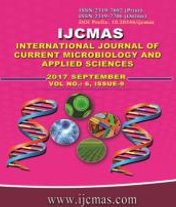


 National Academy of Agricultural Sciences (NAAS)
National Academy of Agricultural Sciences (NAAS)

|
PRINT ISSN : 2319-7692
Online ISSN : 2319-7706 Issues : 12 per year Publisher : Excellent Publishers Email : editorijcmas@gmail.com / submit@ijcmas.com Editor-in-chief: Dr.M.Prakash Index Copernicus ICV 2018: 95.39 NAAS RATING 2020: 5.38 |
16S rrna gene sequencing technology is widely used to determine the microbial diversity which was earlier not possible with traditional methods. It is the most common housekeeping genetic marker which is used to study bacterial phylogeny and taxonomy. In this experiment iron nanoparticles synthesizing bacteria were isolated and characterized by morphological and biochemical test and confirmed by molecular approach using 16S rrna gene sequencing technology. The amplified gene sequence was compared to various bacterial genomes using various computational biology and bioinformatics tools in NCBI sequence database. Phylogenetic relationships and DNA sequencing identified three bacterial isolates as Stenotrophomonas maltophilia KBS 2.4, Bacillus cereus MSS 2.8 and Bacillus cereus MJS 3.0 of 1500bp after carrying BLASTn (NCBI Gene Bank Accession No: MF155656, MF155655, MF155656). Phylogenitic analysis and pairwise alignment revealed its close synteny with related species. A total of 100 bootstrap replications were performed to represent the evolutionary history of the taxa analysed. Using 16S rrna gene sequences, numerous bacterial genera and species have been classified and renamed, classification of uncultivable bacteria has been made possible, phylogenetic relationships have been determined, and the discovery and classification of novel bacterial species has been facilitated. Characterization of iron nanoparticles synthesizing bacteria would be helpful in defining wide variety of applications in near future. Further, in the last decade sequencing of various bacterial genomes and comparison between genomes has confirmed the representativeness of the 16S rrna gene in bacterial phylogeny.
 |
 |
 |
 |
 |